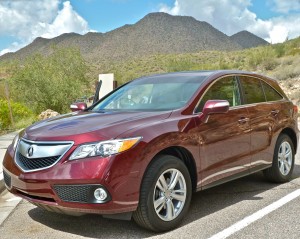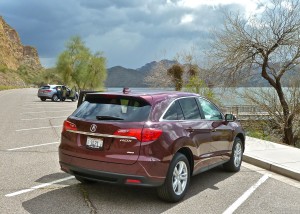Acura RDX undergoes smooth refinement
By John Gilbert
When Honda decided to grace its upscale Acura line with a compact crossover SUV for the 2007 model year, it rolled out the RDX, which was an impressive sports-car-like performer amid a sea of more mundane competitors. That sea has experienced a remarkable rising tide during the past five years, so it’s time for a new RDX that is both an impressive performer and a bit of a contradiction on wheels.
The new design is considerably smoother, playing off the just-introduced Honda CR-V with a distinctly upgraded spin to set it apart from its mainstream sibling. It discards the high-performance turbocharged 4-cylinder engine for the smooth and powerful 3.5-liter V6 that powers the Acura TSX sedan and the Honda Accord and Odyssey van. Handling and connectivity features are among focus points of the new RDX, which has lost the harshness of the first generation’s ride without sacrificing the firm cornering feel.
The new RDX will have base prices of $34,320 for front-wheel-drive models, and $35,720 for a new and more-sophisticated all-wheel-drive system. Built at the East Liberty, Ohio, plant, the RDX will compete with the BMW X3, Audi Q5, Mercedes GLK 350, and Infiniti EX35, according to Acura, but the proliferation of compact crossovers might also throw the Volvo XC-60, Range Rover Evoque, Volkswagen Tiguan, Chevrolet Equinox, GMC Terrain, Ford Edge, Toyota RAV4, Nissan Murano, Hyundai Santa Fe, Kia Sorento, Mazda CX-7 — and its new replacement, the CX-5 — into the fray.
Curiously, while such major players as BMW, Mercedes, Mazda, and Hyundai are proving that switching from six cylinders to four can reduce fuel consumption, and gaining sufficient power from applications of turbocharging in some instances, Acura, which was among the first to try that concept with the first RDX, now is going the other direction — from four to six cylinders — in search for the same improvement in fuel economy.
Jeff Conrad, the Acura vice president, explained that projecting “Generation Y” buying habits have changed from what Honda’s market research had previously projected. “Gen Y is the first generation to earn less money than their parents,” Conrad said. “Luxury vehicles involve emotion, because you’re buying a vehicle not because you have to, but because you want to — and you can.
“But value is now a top priority, and buyers are less interested in horsepower and size, which will cause a fundamental change in the luxury car market. Acura has unique core values, focusing on the driver more than just the machine, on connective technology, and on sustainability. We will remake our whole line with those priorities.”
The shift in priorities among SUV buyers is already taking hold, and the move away from the largest gas-guzzling SUVs has impacted entry crossover-utility vehicles (CUV), mid CUVs, and mid-premium CUVs. The next trend is to premium-entry CUVs, which offer smaller and more maneuverable size, and therefore better fuel economy, but still can be loaded up with the kind of features that are more expected from larger luxury sedans or SUVs. Auto companies have found that buyers may be smarter in their choice of size, but they can still be attracted to the best features and interior elements, which also can mean more profit.
Acura presented the new RDX to the automotive media in Scottsdale, Ariz., in late March of 2012 as a 2013 model. The new design, technology, and features are aimed at attracting younger and more active buyers, using advance technology and exceeding expectations for style, craftsmanship, and quality. The new body has higher rigidity, but feels more comfortable because of improvements in suspension — with double-acting shock absorbers — and better steering feel.
“The previous RDX was positioned well for acceleration, and the new V6 reaches the best in its class,” said Ichiro Sasaki, chief engineer on the new project. “The RDX had focused on agile handling, now there is more emphasis on a high-quality ride. High-speed handling is improved, it’s just that ride comfort is improved more.”
The 3.5 V6 has 273 horsepower, peaking at 6,200 RPMs, and 251 foot-pounds of torque, peaking at 5,000 RPMs. The V6 uses cylinder deactivation to cut down from six, to four, and even to three functioning cylinders under different driving conditions. The changeover from all six cylinders firing, to two on either bank, or to only the three on one bank, and back again to all six, is seamless, and should help fuel economy. EPA estimates reach 28 highway for the front-wheel-drive version, and 27 for all-wheel drive. In city driving, those numbers drop dramatically, to 20 for FWD and 19 for AWD.
The previous RDX had EPA figures of 17 city/22 highway, with the tendency to step hard enough to engage the turbo for quick acceleration mitigating against reaching even those modest figures.
It’s about here where we get some mixed messages from Honda/Acura engineers. When Honda introduced the new 2012 CR-V in October of 2011, engineers emphasized staying with a 5-speed automatic instead of switching to the 6-speeds of many competitors was because it wasn’t needed, thanks to careful revision of the spacing between gears. At the RDX launch, Sasaki said the RDX switches from a 5-speed to a 6-speed for all the obvious reasons of improved fuel economy, reasons which apparently haven’t trickled down to the Honda side of engineering.
The first RDX was truly fun to drive, mainly because Koichu Fujimori, chief engineer of the whole range of impressive Honda 4-cylinder engines, had done a brilliant job of altering the turbocharger. A turbo takes wasted exhaust gas flow and uses it to spin a turbine that powers a generator, which then force-feeds a blast of air-fuel mixture into the cylinders for an increase in power. Turbos usually have a lag, because when you first step on the gas pedal, it takes a few seconds for the volume of exhaust to build enough to properly spool the turbo up to operating speed. Fujimori split a small secondary vane that drew off some of the exhaust flow, and by enlarging the vane, it created a venturi-effect, which accelerates the flow of exhaust. As RPMs built, the exhaust flow crossed over to the main flow. He proved that accelerating a low volume of exhaust was the same as having a larger volume of airflow, and it effectively did away with low-RPM turbo-lag.
It was the sort of exceptional technology we came to expect from Honda engineering. The drawback, however, was great acceleration was offset by distressingly low fuel economy. Nevertheless, I asked Ichiro Sasaki why Acura, when it had a five-year lead on the trend of others to switch from six to four cylinders, chose to go the other direction. “We have the V6 in the MDX, and our customers want it,” he said. “That’s why we’ve chosen to go with the V6. With the 4-cylinder turbo, there was a lag, and it also was quite difficult to further improve fuel economy.”
OK, but from my limited experience driving the previous RDX, and from extensive talks with Fujimori at the previous vehicle’s introduction, turbo-lag was not a problem, and a future week with the new RDX will be necessary to test its fuel efficiency. I do know that while the 3.5 V6 in the new RDX has 273 horsepower, compared to the previous 240 of the turbo 4, the new RDX’s 251 foot-pounds of torque are less than the remarkable 260 foot-pounds Fujimori extracted from the turbo-boosted 2.3-liter 4. If the fuel economy is genuinely improved, the lost torque will be an acceptable compromise, of course.
The new all-wheel-drive system makes a major change from the front-wheel-drive that shifts torque to the rear only as needed. The new RDX has 25 percent of its torque going to the rear wheels at launch, where rear-wheel power maximizes the benefit from the natural weight-balance shift to the rear. During acceleration, 10 percent goes to the rear, and only during highway cruising does 100 percent of the torque go to the front wheels. In snowy or other slippery conditions, the Intelligent Control directs a 50-50 torque split front and rear, and the same 50-50 on hills. If any slippage is detected at any time, 25 percent of the torque switches to the rear.
Overall length of the new RDX is 183.5 inches, width 73.7, and height 66.1, all of which are just slightly larger than the preceding model. There is 26.1 cubic feet of storage behind the rear seat, but if you fold down the rear seat you can reach a maximum cargo volume of 77 cubic feet.
Among its standard equipment are power moonroof, leather heated seats with memory, keyless access, Bluetooth and USB, and rearview camera, which can be adjusted to rer, normal, wide, and top-down views. One of the very neat extra features are the power door locks. Touch the button on the door handle and it locks, hold the handle and, if you have the key, it unlocks. That might be the best keyless entry and exit system in the auto world. Also, if the windshield wipers are activated, your headlights automatically come on too.
If Acura’s projections are accurate, then sales of all crossover utility vehicles will increase, but the entry-luxury compact CUV sales are rising at a much faster rate than midsize, and will pass their larger cousins within three years. That could project that the RDX might overtake the popular Acura MDX in sales. If so, the RDX gives Acura a formidable weapon for the competition.
Comments
Tell me what you're thinking...
and oh, if you want a pic to show with your comment, go get a gravatar!







 John Gilbert is a lifetime Minnesotan and career journalist, specializing in cars and sports during and since spending 30 years at the Minneapolis Tribune, now the Star Tribune. More recently, he has continued translating the high-tech world of autos and sharing his passionate insights as a freelance writer/photographer/broadcaster. A member of the prestigious North American Car and Truck of the Year jury since 1993. John can be heard Monday-Friday from 9-11am on 610 KDAL(www.kdal610.com) on the "John Gilbert Show," and writes a column in the Duluth Reader.
John Gilbert is a lifetime Minnesotan and career journalist, specializing in cars and sports during and since spending 30 years at the Minneapolis Tribune, now the Star Tribune. More recently, he has continued translating the high-tech world of autos and sharing his passionate insights as a freelance writer/photographer/broadcaster. A member of the prestigious North American Car and Truck of the Year jury since 1993. John can be heard Monday-Friday from 9-11am on 610 KDAL(www.kdal610.com) on the "John Gilbert Show," and writes a column in the Duluth Reader.